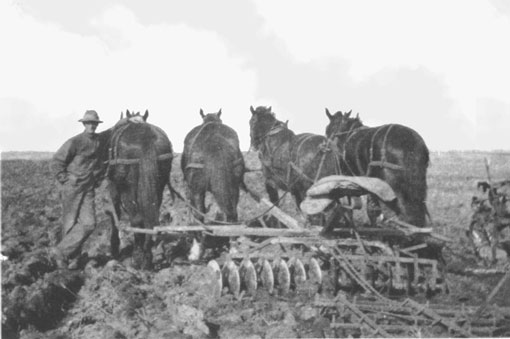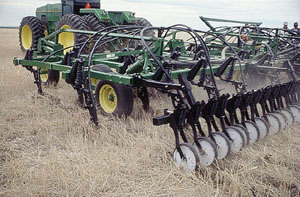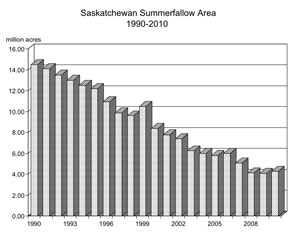Soil Conservation
Success Story
In dealing with Saskatchewan’s own soil erosion problems, our agricultural researchers, equipment manufacturers and farmers have developed and refined low soil-disturbance farming systems. No-till (zero-till) equipment and conservation tillage practices have provided major environmental and economic benefits and have changed the way the land is farmed here and in other grain-producing regions of the world.
When European settlers began arriving in Saskatchewan in the late 1800s, they cleared trees and plowed the native prairie to prepare their lands for field crop production. However, ongoing years of plowing left soils vulnerable to wind and water erosion (Figure 1). The dry years of the 1930s became the “Dirty Thirties” due to wind erosion of soils causing massive dust storms.

Summer fallowing has been another common practice over past decades. Fields were tilled and left in fallow every second or third year in order to store moisture and to control weeds. By the 1980s, soil scientists warned that these excessive tillage practices were seriously depleting soil organic matter and reducing soil health and productivity.

Saskatchewan has been a world leader in the development and adoption of zero-till equipment and production systems that enable continuous cropping and direct seeding into the standing stubble of the previous crop (Figure 2) Benefits include improved soil structure, better moisture conservation, reduced erosion, increased yields, and higher energy and labour efficiencies.
Economic benefits have included the bringing into production of millions of acres of land previously in fallow (Figure 3). As well, Saskatchewan equipment manufacturers export zero-till seeding equipment worldwide.
Zero-till also provides substantial climate change benefits. Reduced tillage and continuous cropping increase soil organic matter and sequester atmospheric carbon dioxide in soils.
Minimizing tillage also supports climate change adaptation. Increased soil organic matter levels enhance moisture-holding capacity and reduce vulnerability to soil erosion. Improved soil health increases agriculture’s resilience through severe droughts and extreme weather events and enables sustained productivity over the long term.
For additional information on zero-till and associated practices see the Saskatchewan Soil Conservation Association (SCCA) or the University of Saskatchewan Agriculture and Bioresources – Soil Science websites.
Sources:
- Agriculture and Agri-food Canada (n.d.): Adapting Dryland Cropping Systems for Drought Conditions. http://www4.agr.gc.ca/AAFC-AAC/display-afficher.do?id=1217595502029⟨=eng [accessed February 3, 2011]
- Sakatchewan Ministry of Agriculture (2010): 2010 June Summerfallow and Seeded Area http://www.agriculture.gov.sk.ca/Default.aspx?DN=0a05f6f5-a8e4-4a4a-bcfd-7e911a675afe [accessed February 4, 2011]
- Saskatchewan EcoNetwork (n.d.): Jim Halford, Saskatchewan’s Environmental Champions http://econet.sk.ca/sk_enviro_champions/halford.html [accessed February 4, 2011]
- Sauchyn, Dave. (2007): Water and Global Warming. A presentation to The Water Series, March 22, 2007 Red Deer, Alberta
- University of Saskatchewan (n.d.): Landscpes Transformed: The History of Conservation Tillage and Direct Seeding. Knowledge Impact in Society http://www.kis.usask.ca/ZeroTill/index.html [accessed February 4, 2011]
